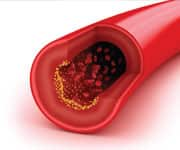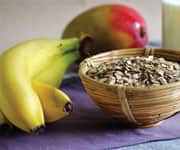Life Extension Magazine®
Long-term Nutritional Supplementation Reduces Progression of Age-Related Macular Degeneration | |
An article published in Ophthalmology reports long-term benefit from supplementation with a nutritional formula containing antioxidants and zinc in men and women with age-related macular degeneration.* Researchers evaluated data from 3,549 follow-up participants in the Age-Related Eye Disease Study (AREDS), which enrolled 4,757 subjects from 1992 through 1998. Participants received a placebo, antioxidant vitamins (beta-carotene, vitamin C, and vitamin E), or antioxidants plus zinc. Eye examinations were conducted with annual fundus photographs and best-corrected visual acuity assessments. Medical histories and mortality were obtained for safety monitoring. Among participants whose macular degeneration was intermediate or advanced in one eye, those who received antioxidants plus zinc during the trial continued to experience a significant reduction in the risk of developing advanced macular degeneration or neovascular macular degeneration in comparison with the placebo group by the end of the follow-up study. Editor’s Note: When mortality was analyzed, those who received zinc were found to have a 17% lower adjusted risk of dying from any cause over a follow-up period of 10 years in comparison with those who did not receive the mineral. The protective effect was strongest against death from circulatory diseases. —D. Dye | |
| Reference | |
* Ophthalmology. 2013 April 10. | |
High Homocysteine Linked with Frailty and Earlier Mortality in Men | |
An article published in The Journals of Gerontology Series A: Biological Sciences and Medical Sciences revealed an association between higher levels of homocysteine and a greater risk of frailty and early death in older men.* The study included 4,248 community-dwelling men aged 70-88 years. Plasma homocysteine levels of 15 µmol/Lor more were measured in samples obtained from 1,117 participants. Of these individuals with high homocysteine levels, 685 were classified as frail. Over an average follow-up of 5.1 years, 749 deaths occurred. Among subjects who had high homocysteine, the risk of frailty was 49% greater than those whose homocysteine was low. High homocysteine was also associated with a 25% increased adjusted risk of dying over follow-up as compared to those with lower homocysteine levels. Editor’s Note: Homocysteine is a damaging amino acid synthesized in the body from the essential amino acid methionine. High levels of homocysteine have been associated with an increase in cardiovascular events and other conditions. —D. Dye | |
| Reference | |
* J Gerontol A Biol Sci Med Sci. 2013 May;68(5):590-8. | |
Higher Omega-3 Levels Linked with Lower Risk of Dying over a 16-Year Period | |
The Annals of Internal Medicine reports the finding of a study of older US adults that uncovered a protective effect for high plasma phospholipid omega-3 polyunsaturated fatty acids against the risk of dying over a 16 year follow-up period.* The study included 2,692 men and women aged 74 years (±5 years) without prevalent coronary heart disease, stroke, or heart failure at baseline. Blood samples obtained during 1992-1993 were analyzed for plasma phospholipid EPA, DHA, and docosapentaenoic acid (DPA). Over 16 years of follow-up, 1,625 deaths occurred, including 359 caused by coronary heart disease and 130 resulting from stroke. Men and women whose total omega-3 fatty acids were among the top one-fifth of participants had a 27% lower risk of dying over follow-up than those whose levels were among the lowest fifth. Editor’s Note: On average, having an omega-3 fatty acid level among the top fifth conferred 2.2 extra years of life after age 65 in comparison with subjects whose level was lowest. —D. Dye | |
| Reference | |
* Ann Int Med. 2013 Apr 2;158(7):515-25. | |
Reduced Melatonin Levels Linked to Greater Diabetes Risk | |
The Journal of the American Medical Association reports a link between decreased levels of melatonin and a greater risk of developing type II diabetes. Melatonin is a sleep-inducing hormone produced by the brain’s pineal gland in response to darkness.* The researchers matched 370 women who developed diabetes while enrolled in the Nurses’ Health Study with 370 non-diabetic participants. Morning urine samples obtained upon enrollment in 2000 were analyzed for the ratio of 6-sulfoxymelatonin (the major metabolite of melatonin) to creatinine in order to estimate overnight melatonin secretion. Women with diabetes had a 6-sulfatoxymelatonin to creatinine ratio that was significantly lower than that of the control group. Among those whose ratio was among the lowest of the participants, their adjusted risk of developing diabetes was more than twice that of women in the highest melatonin group. Editor’s Note: “Further research is warranted to assess if melatonin secretion is a modifiable risk factor for diabetes within the general population,” the authors of the study said. —D. Dye | |
| Reference | |
* JAMA. 2013 Apr 3;309(13):1388-96. | |
The New York Times Shines Spotlight on Hospitals Profiting from Surgical Errors | |
An article by Denise Grady in the New York Times brings to light a study and an editorial from the Journal of the American Medical Association that outlines how hospitals make money from mistakes made in the operating room.* Hospitals make money from their own mistakes because insurers pay them for the longer stays and extra care that patients need to treat surgical complications that could have been prevented, a new study finds. The article states that: The study is based on a detailed analysis of the records of 34,256 people who had surgery in 2010 at one of 12 hospitals run by Texas Health Resources. Of those patients, 1,820 had one or more complications that could have been prevented, like blood clots, pneumonia, or infected incisions. The median length of stay for those patients quadrupled to 14 days, and hospital revenue averaged $30,500 more than for patients without complications ($49,400 versus $18,900). Private insurers paid far more for complications than did Medicare or Medicaid or patients who paid out of pocket. The authors said in an interview that they were not suggesting that hospitals were trying to make money by deliberately causing complications or refusing to address the problem. “Absolutely not,” said David Sadoff, a managing director of the Boston Consulting Group. “We don’t believe that is happening at all.” But, he said, the current payment system makes it difficult for hospitals to perform better because improvements can wind up costing them money. —M. Richmond | |
| Reference | |
* Available at: http://www.nytimes.com/2013/04/17/health/hospitals-profit-from-surgical-errors-study-finds.html?_r=0. Accessed April 21, 2013 | |
Green Tea Extract an Effective Weapon against Alzheimer’s Disease | |
A recent article in the Proceedings of the National Academy of Sciences showed how researchers at the University of Michigan have found a new potential benefit of a molecule in green tea, preventing the misfolding of specific proteins in the brain.* Faculty member Mi Hee Lim and an interdisciplinary team of researchers used green tea extract to control the generation of metal-associated amyloid-aggregates associated with Alzheimer’s disease in the lab. The specific molecule in green tea, epigallocatechin-3-gallate, also known as EGCG, prevented aggregate formation and broke down existing aggregate structures in the proteins that contained metals, specifically copper, iron, and zinc. “A lot of people are very excited about this molecule,” said Lim, noting that EGCG and other flavonoids in natural products have long been established as powerful antioxidants. “We used a multidisciplinary approach. This is the first example of structure-centric, multidisciplinary investigations by three principal investigators with three different areas of expertise.” —M. Richmond | |
| Reference | |
* Proc Natl Acad Sci U S A. 2013 Mar 5;110(10):3743-8. | |
Intake of Fiber and Fiber-rich Plant Foods is Associated with Lower Risk of Some Cancers | |
Plant-based and fiber-rich diets high in vegetables, fruit, and whole grains are recommended to prevent cancer and chronic conditions associated with renal cell carcinoma (kidney cancer), such as obesity, hypertension, and diabetes. A recent study published in the American Journal of Clinical Nutrition investigated the diet habits of a large prospective cohort of US men and women.* Total dietary fiber intake was associated with a significant 15–20% lower risk of kidney cancer in the 2 highest quintiles compared with the lowest. Intakes of legumes, whole grains, and cruciferous vegetables were also associated with a 16–18% reduced risk of kidney cancer. Editor’s Note: Consuming foods with healthy fiber and cruciferous vegetables like Life Extension®’s line of Rich Rewards™ soups is an intelligent step in lowering cancer risk and improving overall health. —M. Richmond | |
| Reference | |
* Am J Clin Nutr May 2013 | |
Fish Oil Supplements May Prevent Skin Cancer | |
Skin cancer is a major public health concern, and the majority of cases are caused by solar ultraviolet radiation (UVR) exposure, which suppresses skin immunity. Omega-3 PUFAs protect against photoimmunosuppression and skin cancer in mice, but the impact in humans is unknown.* A new study published in The American Journal of Clinical Nutrition, revealed that consuming regular doses of fish oils increases immunity to sunlight in humans. Professor Lesley Rhodes, Professor of Experimental Dermatology from the Photobiology Unit Dermatology Centre at the University’s School of Medicine and Salford Royal NHS Foundation Trust, said their study was the first of its kind conducted using humans: “There has been research in this area carried out on mice in the past but this is the first time that there has been a clinical trial directly in people. It has taken a number of years to get to this stage and the findings are very exciting. This study adds to the evidence that omega-3 is a potential nutrient to protect against skin cancer. Although the changes we found when someone took the oil were small, they suggest that a continuous low level of chemoprevention from taking omega-3 could reduce the risk of skin cancer over an individual’s lifetime.” —M. Richmond | |
| Reference | |
* Am J Clin Nutr March 2013 | |
Antioxidant Improves Donated Liver Survival Rate to More Than 90% | |
Results published in a recent issue of Liver Transplantation, a journal of the American Association for the Study of Liver Diseases (AASLD), suggest that the antioxidant N-acetylcysteine (NAC), when injected prior to harvesting of the liver, significantly improves graft survival and complication rates following transplantation even when a suboptimal organ is used.1,2 A 2010 World Health Organization (WHO) report estimates that 22,000 liver transplants were performed worldwide, with nearly 18,500 from deceased donors. “Liver transplantation is the standard treatment for end-stage liver disease,” explains lead author Dr. Francesco D’Amico from Padova University in Italy. “Antioxidants such as NAC could potentially reduce damage to deceased donor livers, improving graft function.” Studies have shown that ischemia-reperfusion injury (IFI)—damage to the liver tissue when blood supply returns to the liver after lack of oxygen (ischemia)—often occurs during storage and preservation of donated livers and impacts early graft function post-transplantation. Dr. D’Amico concludes, “Our study was the first randomized trial to investigate the use of NAC antioxidant infusion during the liver procurement procedure. We propose that NAC be used during organ harvesting to improve liver transplantation outcomes, particularly with the increased use of suboptimal organs.” —M. Richmond | |
| Reference | |
| |
Black Tea Lowers the Rate of Blood Pressure Variation | |
Measures of blood pressure variation have been associated with cardiovascular disease and related outcomes. The regular consumption of black tea can lower blood pressure, but its effects on blood pressure variation have yet to be investigated. A recent article in the American Journal of Clinical Nutrition set out to determine whether this was the case.* The study included men and women with systolic blood pressure between 115 and 150 mmHg at screening. They were recruited in a randomized, controlled, double-blind, 6-month parallel-designed trial designed primarily to assess effects on blood pressure. Participants consumed 3 cups/day of either powdered black tea solids (tea) or a flavonoid-free caffeine-matched beverage (control). The 24-hour ambulatory blood pressure level and rate of measurement-to-measurement blood pressure variation were assessed at baseline on the first day and at three-and six-month intervals. Across the time points, tea, compared with the control, resulted in lower rates of systolic and diastolic blood pressure variation during the nighttime. These effects, which were immediate at day one and sustained over six months, were independent of the level of blood pressure and heart rate. The rate of blood pressure variation was not significantly altered during daytime. —M. Richmond | |
| Reference | |
* Am J Clin Nutr May 2013 | |
Research Provides New Insight Regarding Transmission of the Influenza Virus | |
Although there is little data on their benefit, the Centers for Disease Control recommend that healthcare centers provide surgical masks to suspected flu patients in an effort to reduce aerosol transmission of the influenza virus. A study conducted by a research team at the University of Maryland found that people may be exposed to the flu through airborne virus more frequently than previously thought. The study also found that when flu patients wear a surgical mask, the release of virus in even the smallest airborne droplets can be significantly reduced.* “Our study provides new evidence that there is nearly nine times more influenza virus present in the smallest airborne droplets in the breath exhaled from those infected with flu than in the larger droplets that would be expected to carry more virus. This has important implications for how we prevent the spread of flu,” explains Donald Milton, MD, DrPH, Director of the Maryland Institute for Applied Environmental Health that led the study of aerosol spread of the influenza virus that was published in the journal PLOS Pathogens. Dr. Milton and his team collected samples of exhaled particles (one with and one without a facemask) in two sizes (fine and coarse) from 37 volunteers within 5 days of seasonal influenza onset, measured viral copy number, and tested the fine-particle fraction for culturable virus. Overall, masks produced a 3.4 fold reduction in viral aerosol shedding. —A. Pryce, ND | |
| Reference | |
* PLoS Pathog. 2013 Mar;9(3):e1003205. |







